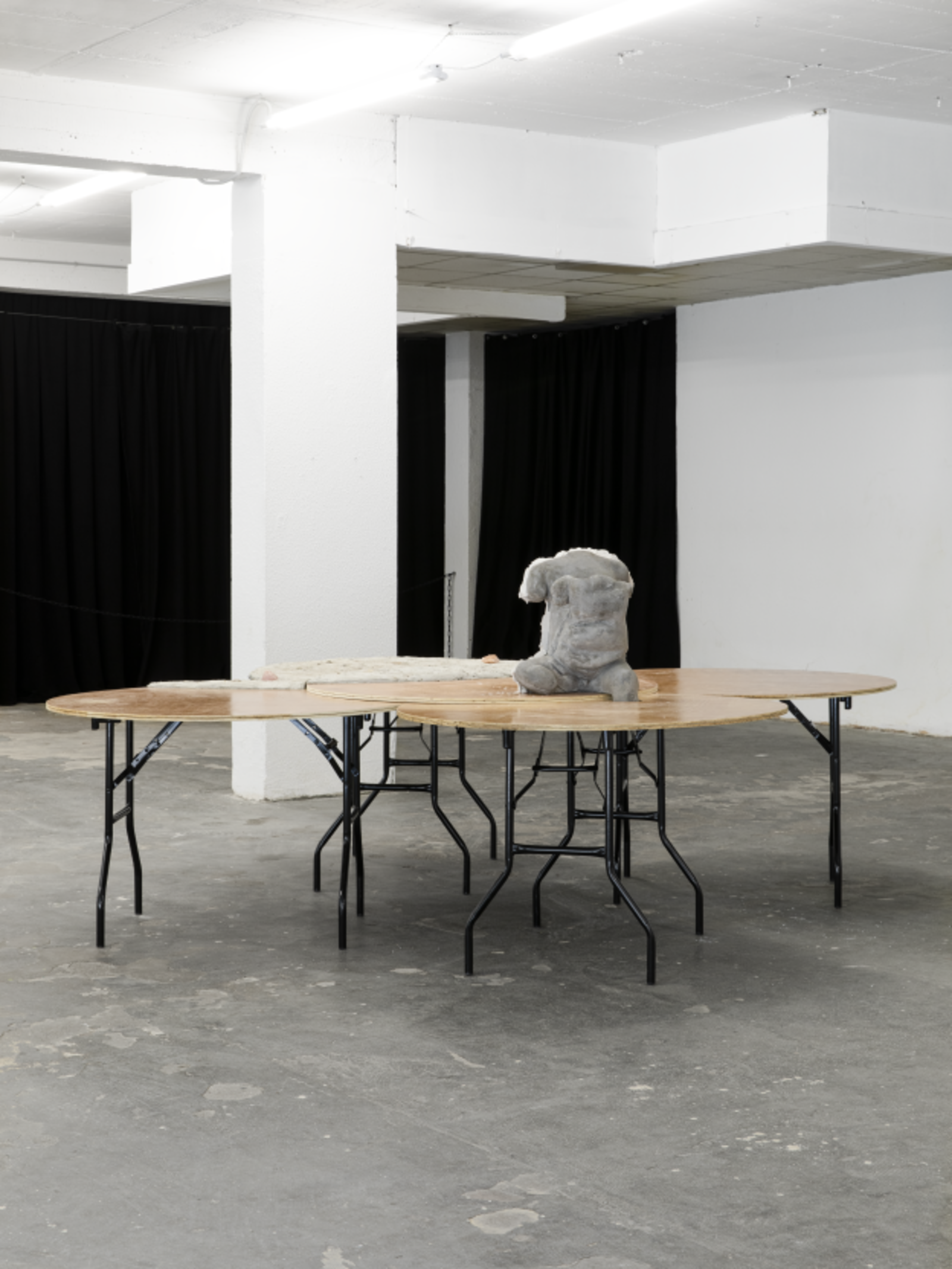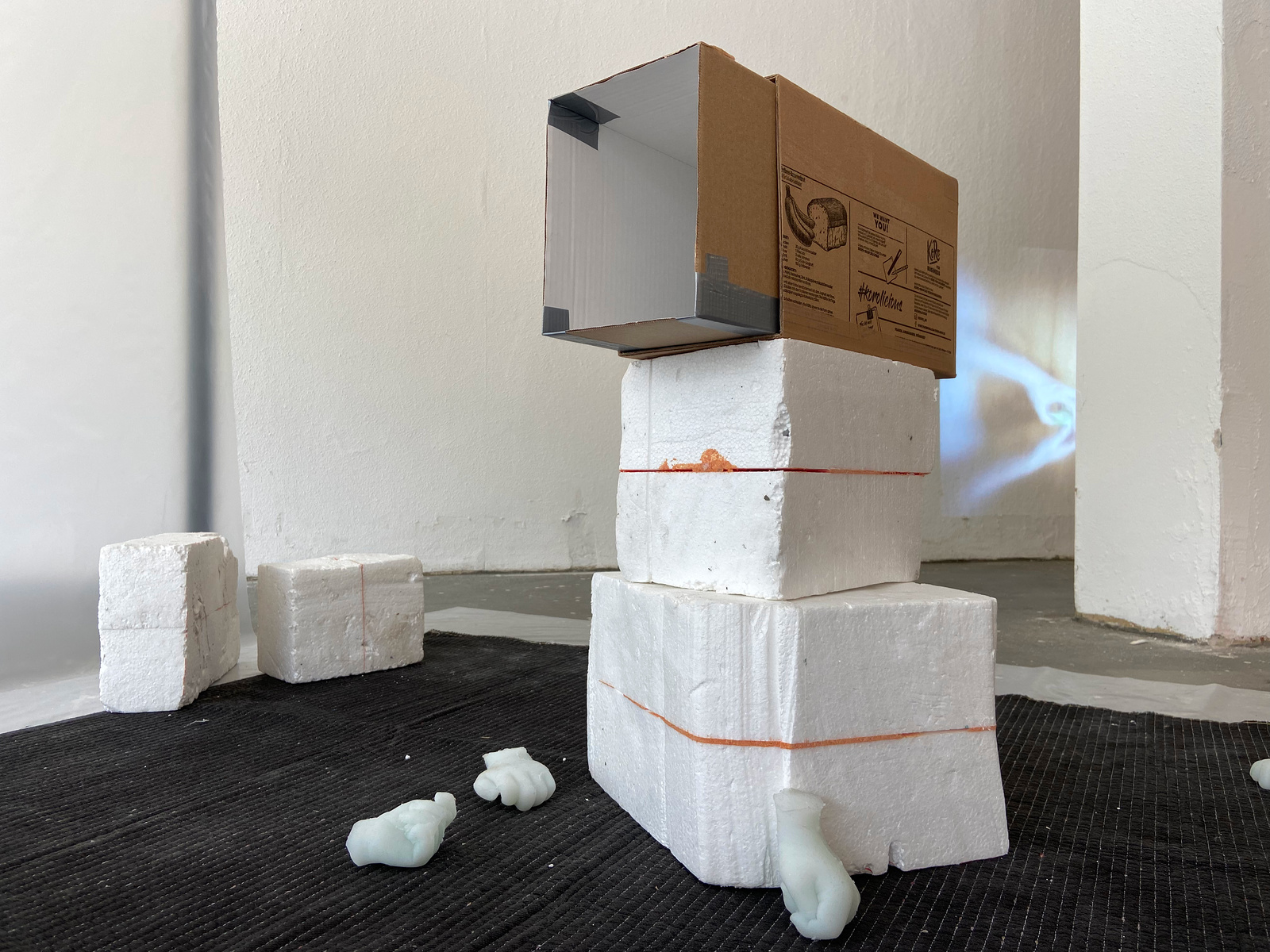Four Notes on Yu Ji: Miss Shell, Delta, and Two Noughts
1.
For three months as winter slowly conceded to spring, Yu Ji and her four-year-old son Jier walked the streets of Berlin.[1] I often wondered about their mode of walking: Do they go hand in hand, small feet pattering alongside mother’s stride? Do they see what the other sees despite the difference of altitude, each pebble, insect, cigarette butt and empty wrapper of shiny things, the strange hang of a cloud, the curved weight of a passerby’s gait or gaze? Do they bring back a piece of the world, seeds stuck in shoe laces, dirt under fingernails, handfuls of stolen gravel in a plastic bag?
Picturing a mother carrying a child, I wondered at which point the minuscule slip of air between two bodies would disappear, boundary giving way to the indistinguishableness of flesh. The answer seems to be sitting right over there on the table at the corner of my eye, yet gone again when I turn to look. Yu Ji titled the work Ghosts, this table piece she’d once put together for an exhibition at Chisenhale Gallery by giving instructions from a locked-down Shanghai to London over zoom.[2]

Yu Ji, Miss Shell, Delta, and Two Noughts, Installation view, CCA Berlin, 2023. Photo: Diana Pfammatter/CCA Berlin
The new version sitting on the table evading my questions, is handmade by her after all—made by her own two hands, in other words, a negative to her hands and their extensions (tools) as malleable sludge yielded to the movement and shape and force of them. A stone-studded pool of cement repeats brokenly the roundness of the rounded tables, just as one fold of flesh repeats after the other. Whereas the original title 叠影 images an overlap, a double, a stack or stacking of shadows, this formality of a stutter or duplex gets lost in the translation. Though it might be still readable how the folded flesh, as a mutating derivative, lifts off of and/or melts back into the torso, I become increasingly forgetful of how the torso behaves the same in relation to the plaster behind it—a stone-grey mass emerging from, retreating into its own white shell, its jagged womb and negative cast. Ghost on ghost on ghost.
So I wondered, in what way does a mother’s body continue to constitute the negative of a child, once the new-born has shed its round-bellied mould?
2.
The new works produced during her three-month residency at CCA Berlin are a continuation of the long-term sculptural series Flesh in Stone (石肉), which has occupied a central place in Yu Ji’s practice since 2012. The earlier works depict fragments of body made of plaster and clay, each holds their incompleteness with different degrees of tension or laxity, each sprawls or floats or sinks in different poised manners, but almost always sexless, headless and limbless, with absent hands and feet. In this ongoing rigorous study of the body, all that which is stripped away seems to be in excess of Yu Ji’s understanding of “flesh”, or rather, in excess of her quasi animistic fascination with 肉, which in Chinese context does not differentiate between flesh and meat, sometimes does not even contain blood or bone on account of an interior-less density. Her object of fascination, this “stony meat”, is thus best embodied (enfleshed) by the opaque torso, the least “Human” part of the human body—some might even say body without organ—as it is devoid of identity and individuality (instituted by head, face, groin), intention and will (concretised through actionable appendages).
Yet, hands have made a curious appearance in Miss Shell, Delta, and Two Noughts. A series of black-and-white photographs investigates and coalesces the hand gestures from daily life and from a sculptor’s labouring. On the floor, two small silicone fists stick out of a hollowed-out torso shaped like a shell curling in on itself, one on top of the other, hovering and holding secrets. Hands folding paper flower, hands collecting tulip petals, hands scattered around the work station like pearls among sand or found material from the street forgotten to be packed away, each soft green and semi-translucent.

Detail, Yu Ji, Miss Shell, Delta, and Two Noughts, CCA Berlin, 2023. Photo: Nan Xi
I remember pointing to them and asking Jier if those were his hands, already knowing the answer to be yes but temporarily forgetting the Chinese words for “modelled on”. He stared at me for a moment, then said with utmost certainty: “No, not my hands.” Without dismissing it as misunderstanding, I started to wonder what it means to disown my hands, what it means for flesh to disown its shadow like setting free a phantom limb. Can a certain gesture be shed from the body and become a ghost? How can we own the ownership of our own body if its contours and movements and actions are constantly peeling off, running away, fleeing from the host?
The name Ji-Er means literally “The son of Ji”. But when pronounced softly as it is vernacularly voiced in a name, the character “Er” loses its gendered and familial meaning. It becomes a signal for endearment alone, the possessive bond of blood queered into an affix tuned for the ears of the beloved. Yu Ji and Jier. Do the syllables of these names flee from each other or hold each other close?
3.
Yu Ji was mixing some cement in a small bucket, her back haunched, both hands muddied with white and grey. The hypnotic, ding-dongy soundtrack from a children’s cartoon suddenly broke off into a car advertisement. Jier turned restless on the chair next to me, swaying his feet back and forth under the table. As if on cue, Yu Ji straightened up from her work and turned around. “Can you skip the ad for him on the iPad, my hands are dirty.” Weeks later, as mother and son have already relocated to New York, I mentioned this moment to Yu Ji on zoom, a little embarrassed by the inconsequentialness of my memory. She didn’t remember, but laughed and confirmed easily when I explained my clumsy speculation on the incompatibility between artist’s hands and mother’s hands, how their activities often overlap or stand in the way of each other. Later on, the thought came back to me doubly troubled: Does this juxtaposition of hands not (re-)perform an interpretive logic which through the mechanisms of neoliberal valorisation and systemic precarization reduces both care labour and creative labour down to a conflict of interest between occupation a and b? And secondly, is the emphasis on motherhood as identity—condensed into art-historical categories of “mother-artist” or “maternal art”—not potentially as reductive and violent as sticky labels such as “queer artist”, “woman artist”, “Black artist” or “Chinese artist”?
If flesh and stone make up indeterminable matter-mass-thing-being underneath or against the working of representation, which is to say, if the works of Flesh in Stone refuse to conform to the compulsive divide between form and content, a compulsion that reveals its linguistic root in the insertion of the preposition “in” in the title to generate sense, then their ambivalent presence would immediately or eventually repel any adhesive labels and the imposition of preexisting meanings.[3] But that immediate or eventual concede to opacity seems to demand a great deal of work from us too. It requires a slowing-down from vision to thought, an event of encounter stretched into a prolonged simmering of senses, an abolition of certain ingrained pathways as well as certain tendencies towards interpretation and subject-object interpellation, and a tacit recognition that “living matter evades but does not outrun the decay to equilibrium”[4] yet evades still. The matter that joins the living and unliving is not a matter of the sequentiality of life, but its fractality—an infinite multiplication of ghosts.[5]
4.
So instead of reiterating the site-specificity of the materials in use—a delimiting terminology that has steered the discourse on Yu Ji’s work long before she had set foot “in the west”, I wondered whether it may be beneficial to deviate from those terms, not in order to chase the myth of authenticity, but to make use of mistranslation, one step further. This deviation starts with an awareness that what is specific to a site and rendered visible is always already implicated in a more intimate layer of specificity—the particular relationship between a site and the I that roams the site and whereby traces the contours of its own psychic landscape like on a sheet of tracing paper. So instead of specificity to physical site, I read an implicancy of the limitation or freedom of self-displacement, where the uncertain, vulnerable state of being-on-the-move, the encumbered measurement of the right to mobility are both intimated in the flesh.
Another open secret in the room: a curled-up note left on the wall for those who might be in the know: “On the last day before leaving Shanghai, we went to the seaside. The sea most familiar to me, became however foreign.”[6] Insofar as the optics of Yu Ji’s work withholds from the overdetermination of the racialising, gendering gaze, it opens up to a field of shared desires and intimacies, in which the act of wandering disrupts and reinvents the spatial and temporal delineation between the known and the unknown. If past experiences of confinement and isolation have taught us one thing, it might be that moving is not a luxury, but like food and water, a requirement for living. So instead of opposite ends, I see an open-ended question embodied in the study of Stone-Flesh: Is it possible to imagine movement and stillness as an adjacent pair not mediated by any preposition, touching like flesh embracing flesh, one implicated in the other?
On a rainy day in May, a mother and a son traveled from city a to city b. Somehow I imagine their wandering would continue over there, with no promise of return or arrival, in another known and unknown place, on streets that are both strange and familiar, probably leaving behind a new trail of ghosts.
[1] This text is written by Nan Xi on the occasion of Yu Ji's first solo exhibition in Germany with newly commissioned works produced during her three-month residency in Berlin, as part of CCA Berlin’s artist in residence program.
[2] Yu Ji's solo exhibition Wasted Mud, Chisenhale Gallery, London, 22 May–18 July 2021.
[3] For the original title 石肉 reads “stone flesh”: This unmediated adjacency of nouns refuses to specify a relation of “as, in, from, to, of…” but simultaneously implicate each and all.
[4] A variation on Schrödinger’s second law of thermodynamics.
[5] The mathematical notion of fractality produces a guiding image for thinking about the relationship between the sociohistorical conditions of life and the individual as infinitely expanding patterns, in which every singular existence is implicated within and by each other. Understood as such, the figure of the fractal is a way of understanding the human and nonhuman interdenpendence, an attempt at bridging subjectivity with objectivity.
[6] Originally hand-written in Chinese.